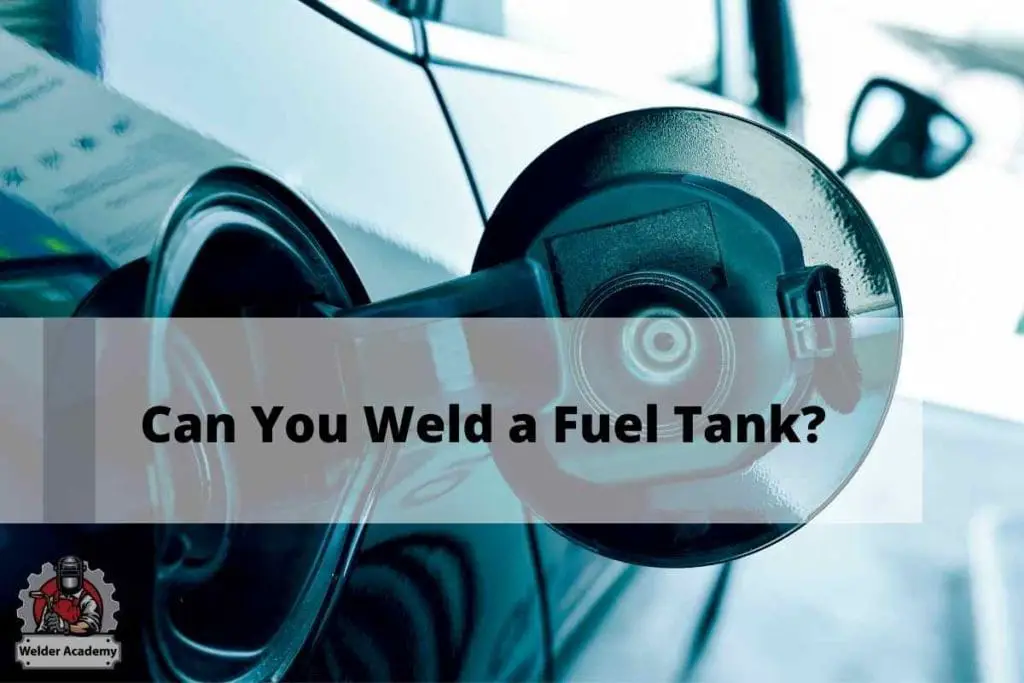Fuel tanks can often suffer from minute holes or leaks. And these leaks need immediate attention. Failure to repair them in time will make you lose precious fuel. Plus, there’s always the risk of explosions or fire hazards. Welding seems like the solution in this case. But can you weld a fuel tank? Is it safe? Well, let’s find out.
Welding fuel tanks is one of the most dangerous types of welding work. Welding a fuel tank is like literally working on a fuel bomb, given that you do the job without proper precaution and preparation. The possibility of an explosion and subsequent burn injuries and fire hazard is very real when you weld a fuel tank.

However, if there’s a fuel tank that is leaking, somebody has to repair it. And welding is the quickest and most effective way to accomplish that. So, how can you do it without turning yourself into a kebab? The following sections answer that.
What Are The Dangers Of Welding A Fuel Tank?
Can you weld a Fuel tank? Well, you can. But not without proper precautions.
Fuel tanks are one of the most dangerous things to bring near a welding torch. The common dangers include explosion, burn injuries, fire hazards, and similar. Moreover, there is also the risk of asphyxiation from harmful gases.
A fuel-bomb
Some people might think that fuel like petrol or diesel is liquid. So why worry about gasses? But in reality, a partially filled petrol tank will have the air in the emptiness filled with vaporized gasses. And this essentially turns the tank into a fuel-air bomb when it comes in contact with welding sparks.
To be more precise, the gaseous form of petrol will react more aggressively and uncontrollably when it comes in contact with an ignition source. Because the extra oxygen present in the mixture of air and fuel gasses influence it to burn faster.
An explosion or fire hazard is the gravest concern when welding a fuel tank. And this can happen even when the tank is fully empty. Or so it might seem. Because even a fully empty tank can have some leftover vapors of fuel inside it. And when that comes in contact with a welding torch it can easily ignite and cause combustion.
Flying Sparks
One of the biggest concerns when welding a fuel tank is the sparks. During any welding process, the flying of sparks is unpredictable and often difficult to control. And although small, welding sparks can reach astonishingly high temperatures.
If the vapor from residual fuel comes in contact with these sparks it will result in combustion. Subsequently, it can give you a small burn injury. However, there is always the chance of greater dangers like an explosion, or fire hazard.
Moreover, welding sparks can fly off to considerably good distances. And the molten metal can get stuck in a variety of items. Such as clothes, pipes, cracks, and others. This incident also has the potential to cause a fire.
The combined effect of both the gas combustion in the fuel tank and fire from the molten metal can bring about a disaster of great magnitude.
Asphyxiation hazards
Another danger of welding a fuel tank is the risk of asphyxiation from argon gas. This gas is used in Metal Inert Gas or Tungsten Inert Gas as a shielding material. Because argon is considered a lazy gas and prevents any reaction from happening.
The gas does not necessarily kill you. However, it has the property to asphyxiate someone. The effects can manifest even in small amounts. But this is becoming a more real and serious risk when you are working on a large fuel tank.
First of all, you cannot be aware of the gas. Because, being inert, it is devoid of scent and color. In addition, if there is a lack of proper ventilation in the area where the welding is taking place, the asphyxiating effects of Argon can take place suddenly without any notice.
How To Safely Weld A Fuel Tank?
So, welding a fuel tank is dangerous. But people still do it, right? And not everyone gets blown away while taking on the task. So, the question is not can you weld a fuel tank. Rather, you should be asking how you can safely weld a fuel tank? Well, it is not that difficult. Just take heed of the following points.
As mentioned earlier, welding sparks can fly off to distances and can add to the already present hazard of fuel vapor combustion. What might have been a little combustion, can easily turn into a full-blown disaster due to this behavior of the molten metal droplets.
So, remove all sources of ignition, flammable materials, leaking pipes and chambers from your workplace. Also, use proper welding techniques to keep the sparks controlled and at a minimum.
Secondly, before you start working, drain the fuel tanks of any kind of residual fuel and vapor. You should do this in an open space and preferably a spot far from your actual workplace. Otherwise, the lingering vapors in the air around might ignite when you start the welding process.
Also, make sure to use proper equipment for draining. Don’t use a makeshift tool to clean or handle the residual fuel.
Working fuel tanks, like that in vehicles, will have a fuel line attached to them. Besides draining the tank, don’t forget to make sure that the line is cleared too. Otherwise, you will still be at the same risk of a burn injury or explosion.
Proper ventilation is very important when welding anything. So, unless you are welding in an open area, ensure that your workplace has adequate ventilation. This will save you from the effects of Argon gas. Plus, it will also lower the risk of an explosion or combustion.
A good technique for safe fuel tank welding is filling the tanks with a little amount of water. When the water rests at the bottom of the tank, it will displace the residual fuel vapor at the bottom. So, during welding, when the sparks fall at the bottom, there won’t be any chance of accidental ignition.
Lastly, make sure your welding tools are in standard condition. Plus, you also need to arrange for all the proper safety equipment.
These include goggles, face shields, fire repellent helmets, fire-resistant jackets and boots, and respirators. Such items ensure that in the unfortunate event of an accident you will have maximum protection.
Helpful Tips for Welding A Fuel Tank
Here’s some further discussion on fuel tank welding. These are not safety tips. But you will find them helpful in other aspects of the job.
Aluminum tank: Welding a fuel tank made of aluminum or stainless steel can pose quite a challenge. These materials behave whimsically when exposed to a welding flame.
So, to avoid difficulties, precisely identify the grade of the metal, before you start. After that, match your gas level accordingly. This will make your work easier.
Cleaning the tank: When you are cleaning a fuel tank to rid it of residues, use soap and water. Plus, you will also want to repeat the cleaning process several times. Before that, turn off the line or any other active connections to the tank.
After cleaning the tank, carefully dispose of the mixture of soap, water, and fuel. Because that mixture has the potential to be flammable and can cause dangers if you dispose of it improperly.
Avoiding fuel tanks holes: Fuel tanks get leaks and cracks from the direct and indirect impacts of driving on bumpy roads. Another cause is the build-up of rust and salt in the undercoat.
While you might not always be able to avoid bumpy roads, you can do something about the rust and salt buildup. Take the time to check and clean your fuel tank every once in a while. In that way, you can avoid holes or leaks on a relatively good-conditioned fuel tank and avoid welding it altogether.
Conclusion
So, can you weld a fuel tank? You now know the answer to that question better than most people by now. Welding a fuel tank is always a risky job. But you can significantly lower that by taking proper preparation, safety precautions, and by being careful overall.
Is it Safe to Weld on A Car? 8 Essential Safety Tips
Is It Safe To Weld Indoors?
